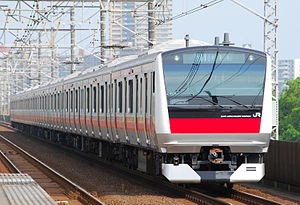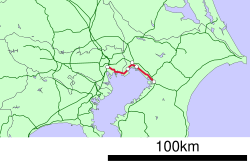Keiyo Line
| Keiyō Line | |||
|---|---|---|---|

A Keiyō Line E233-5000 series EMU, July 2010
|
|||
| Overview | |||
| Native name | 京葉線 | ||
| Type | Commuter rail | ||
| Status | Operational | ||
| Locale | Tokyo, Chiba Prefecture | ||
| Termini |
Tokyo Soga |
||
| Stations | 18 | ||
| Operation | |||
| Opened | 1975 | ||
| Owner | JR East | ||
| Character | Underground, at-grade, elevated | ||
| Depot(s) | Narashino | ||
| Rolling stock | E233-5000 series, 209-500 series | ||
| Technical | |||
| Line length | 43 km (27 mi) | ||
| Track gauge | 1,067 mm (3 ft 6 in) | ||
| Electrification | 1,500 V DC overhead catenary | ||
| Operating speed | 100 km/h (60 mph) | ||
|
|||
The Keiyō Line (京葉線 Keiyō-sen?) is a railway line connecting Tokyo and Chiba in Japan, paralleling the edge of Tokyo Bay. It is operated by the East Japan Railway Company (JR East). The line forms part of what JR East refers to as the "Tokyo Mega Loop" (東京メガループ?) around Tokyo, consisting of the Keiyo Line, Musashino Line, Nambu Line, and Yokohama Line. It provides the main rail access to the Tokyo Disney Resort and the Makuhari Messe exhibition center. The terminus at Tokyo Station is located underground, some distance to the south of the main station complex approximately halfway to Yūrakuchō Station. This means transfer between other lines at Tokyo Station can take between 15 and 20 minutes. The name "Keiyō" is derived from the second characters of the names of the locations linked by the line, Tokyo (東京?) and Chiba (千葉?). It should not be confused with the Keiō Line, a privately operated commuter line in western Tokyo.
...
Wikipedia

